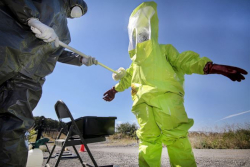Chemical Removal
Removal of gross contamination should be followed by a wash/rinse process using cleaning solutions.
Physical removal of gross contamination should be followed by a wash/rinse process using cleaning solutions.
These cleaning solutions normally use one or more of the following methods:
- Dissolving contaminants: Chemical removal of surface contaminants can be accomplished by dissolving them in a solvent. The solvent must be chemically compatible with the equipment being cleaned. This is particularly important when decontaminating personal protective clothing constructed of organic materials that could be damaged or dissolved by organic solvents. Care must be taken in selecting, using, and disposing organic solvents that may be flammable or potentially toxic. Organic solvents include alcohols, ethers, ketones, aromatics, straight- chain alkanes, and common petroleum products.
- Halogenated solvents generally are incompatible with personal protective equipment and are toxic. They should only be used for decontamination in extreme cases where other cleaning agents will not remove the contaminant.
- The list below provides a general guide to the solubility of several contaminant categories in four types of solvents: water, dilute acids, dilute bases, and organic solvents. Because of the potential hazards, decontamination using chemicals should be done if recommended by an industrial hygienist or qualified health professional.
- Surfactants: Surfactants augment physical cleaning methods by reducing adhesion forces between contaminants and the surface being cleaned, and by preventing redeposit of the contaminants. Household detergents are among the most common surfactants. Some detergents can be used with organic solvents to improve the dissolving and dispersal of contaminants into the solvent.
- Solidification: Solidifying liquid or gel contaminants can enhance their physical removal. The mechanisms of solidification are:
- moisture removal using absorbents such as grounded clay or powdered lime;
- chemical reactions via polymerization catalysts and chemical reagents; and
- freezing using ice water.
- Rinsing: Rinsing removes contaminants through dilution, physical attraction, and solubilization. Multiple rinses with clean solutions remove more contaminants than a single rinse with the same volume of solution. Continuous rinsing with large volumes will remove even more contaminants than multiple rinsings with a lesser total volume.
- Disinfection/Sterilization: Chemical disinfectants are a practical means of inactivating infectious agents. Unfortunately, standard sterilization techniques are generally impractical for large equipment and for personal protective clothing and equipment. For this reason, disposable PPE is recommended for use with infectious agents.
Knowledge Check Choose the best answer for the question.
3-6. Which cleaning solutions reduce adhesion forces between contaminants and the surface being cleaned?
You forgot to answer the question!

